Clash of Titans
Games featuring a future Hall of Fame coach on each sideline.
September 27, 1941: Missouri @ Ohio State
Don Faurot vs Paul Brown
The late December holiday was still three months away, but it still felt like Christmas morning when Ohio State opened its 1941 season. The game against Missouri was the first for new Ohio State coach Paul Brown, the 33-year-old wunderkind from Massillon High School who brought a sterling prep record (80-8-2) as well as the discipline and organizational skills that had gone missing under slap-dash coach Francis Schmidt. Brown in September 1941 was a star based on potential alone—but potential was enough to make OSU fans giddy. The first step came against a Missouri team coached by Don Faurot, who coincidentally was among the four finalists for the Ohio State job that Brown got. ("Rear-view mirror: Ohio State vs. Missouri (1941)", The Columbus Dispatch, September 24, 2014)
Faurot was in his sixth season as Missouri coach with a cumulative record of 32-18-5. His mark the last three years was 20-8 when he had All-American Paul Christman as his quarterback.
Fauret Creates New Offense
With Christman gone, Faurot decided to revamp his single wing offense. He remembered with a shudder the disaster that followed the departure of Jack Frye's passing arm after the 1936 season. The Tigers fell from 6-2-1 in '36 to 3-6-1 in '37 before Christman became eligible in '38.
Faurot spent a huge amount of time in the off-season designing a completely new offense. He wasn't reinventing the wheel. The 1940 Chicago Bears of George Halas had sprung the modernized T-formation on pro football. It was designed by offensive coordinator Clark Shaughnessy, who left to coach Stanford for the 1940 season. The quarterback no longer squatted behind the center but merely crouched, hands under the crotch so that he took a direct handback rather than a snap. A halfback went in motion to create better passing situations.
The Bears slaughtered the Washington Redskins in the 1940 NFL championship game 73-0. Stanford surged from nowhere to the Rose Bowl, where they defeated Nebraska 21-13.
Faurot watched Nebraska's Rose Bowl film and decided what he wanted to do. He ruled out the man-in-motion because the last-second movements by the defense in response to the motion made it more difficult for offensive linemen to carry out their blocking assignments.
Wanting to give his quarterback more mobility and potential as a runner, Faurot eliminated the quarterback pivot from under center and substituted a slide that permitted the running back to take the ball closer to the line of scrimmage on dive plays. Also, he gave the quarterback a keep-or-give option on every play.
If the quarterback kept the ball, he moved down the line toward an unblocked end. "I wanted to pressure the defensive end with what amounted to a 2-on-1 break in basketball," said Faurot. If the end came toward him, the quarterback would flip a lateral to the trailing halfback . If the end held his ground, the quarterback kept the ball and cut upfield.
Faurot had already spread his offensive line in the single wing. But now he split them even further, leaving 12" between center and guard, 2' between guard and tackle, and a yard between tackle and end.
His offense was known as the "Split T," although "Sliding-T" might have been a more accurate monicker. It succeeded beyond Faurot's expectations, becoming a staple of college football for decades.
Missouri's outstanding C Darold Jenkins recalled years later: "We never had to hold our blocks as long as we did in the single wing offense. Also, playing defense against the single wing, linebackers had to wait a full count before committing themselves. If they waited a full count against the Split-T, all they saw were cleats."
Between spring and fall practice, Faurot wasn't able to install all aspects of his new offense in time to face Ohio State. He hoped he had enough surprises to pull the upset.
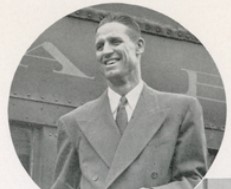
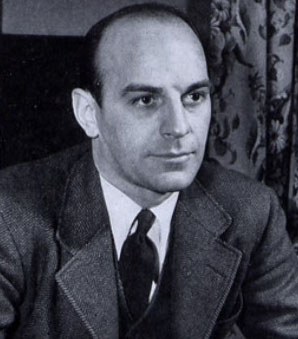
L: Don Faurot (Univerrsity of Missouri Savitar Yearbook Class Of 1942)
R: Paul Brown (Ohio State University Makio Yearbook Class of 1942)
OSU Hires Brown Despite His Lack of College Experience
Faurot also had to get his defense ready to handle what Ohio State's new coach would spring on the Tigers.
Paul Brown became a legend in Ohio as a high school coach. The native of Norwalk OH became head football coach at Massillon Washington High School at age 23. His teams lost only 10 games in 11 seasons.
When Ohio State had enough of Coach Francis Schmidt, Brown became the overwhelming choice of Buckeye fans as the replacement. However, the leading candidate was Don Faurot of Missouri. But the Ohio High School Football Coaches Association endorsed Brown for the position with an implied threat that they would steer their top players away from Ohio State if he was not given the position. So OSU Athletic Director Lynn St. John, who had wanted to hire a coach with college experience, changed his tune and signed "The Massillon Miracle Man."
Brown inherited only eight lettermen from the 1940 Ohio State team. He had 23 sophomores, three of whom would play for Brown when he became the Cleveland Browns' coach after the war—E Dante Lavelli, G Bill Willis, and HB Tommy James.

Ohio State (dark jersies) runs an end sweep. (University of Missouri Savitar Yearbook Class Of 1942)
Ohio State Stifles Mizzou's New Offense
49,671 fans watched a spine-tingling contest in almost mid-summer heat that kept intact the Buckeyes' incredible streak of never losing an opening day game since 1894. It also extended Brown's personal winning streak to 34.
The Buckeyes held Mizzou's new offense scoreless in the first half. After returning the opening kickoff to the 35, the Bucks started on an impressive display of power football. Using nothing but straight plays, they hammered their way to the Missouri 18 before losing the ball on a fumble.
The Tigers quickly moved across midfield. First, HB Harry Ice started around left end, and when tacklers closed in, he lateraled to HB Bob Steuber, who kept going until senior S Jack Graf pulled him down on the OSU 44. Two plays later, Steuber zipped through left tackle for 28y to the 15 where Graf made another touchdown-saving tackle. But the defense tightened, and Missouri had to turn over the ball on downs at the 12.
Brown recalled how his staff reacted to Missouri's new alignment.
Faurot had used the Notre Dame box formation in his spring game, and we had seen nothing then that warranted any alarm. Of course, he had strategically hidden the split T and all its new techniques. Instead of positioning themselves a conventional six inches from the center, the guards split a yard or a yard and a half, and the tackles split the same distance from the guards. Now at that time defensive linemen were always taught to take their spacing from the position of the offensive linemen—for instance, a defensive tackle might be taught to play off the inside shoulder of the man opposite him. If they did that now, however, huge splits would open up in our defensive line, into which the quarterback could easily pop through or hand the ball to a running back. To increase the line's effectiveness further, Faurot had also developed the brush block, in which the offensive linemen hit the defensive man hard enough to seal him off or knock him off-balance for just the instant it took the quarter or halfback to bolt past.
We had never even thought about such things, and Missouri started ripping through us right from the start. Our players were totally confused, and we had to make an instant decision.
"Just keep your normal distances in relation to your teammate next to you," we told them, because we could think of nothing else at the time. "Let them split from sideline to sideline if they want to, but you stay in your same relative position."
That desperate decision saved us, and from then on we played with the traditional 6-2-2-1 defense. Missouri drove up and down the field, with Don Greenwood, Harry Ice and Bob Steuber putting on a stunning show of offensive football.
We had never even thought about such things, and Missouri started ripping through us right from the start. Our players were totally confused, and we had to make an instant decision.
"Just keep your normal distances in relation to your teammate next to you," we told them, because we could think of nothing else at the time. "Let them split from sideline to sideline if they want to, but you stay in your same relative position."
That desperate decision saved us, and from then on we played with the traditional 6-2-2-1 defense. Missouri drove up and down the field, with Don Greenwood, Harry Ice and Bob Steuber putting on a stunning show of offensive football.
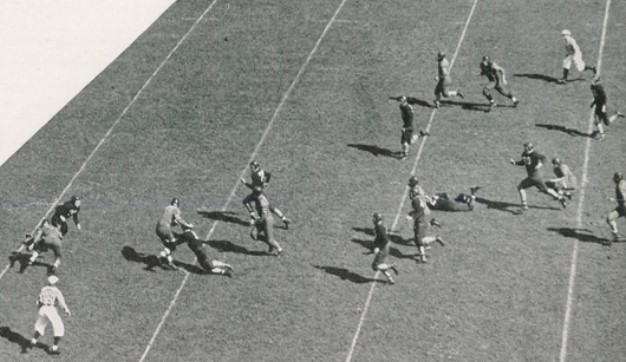
Bob Steuber is tackled after long gain. (University of Missouri Savitar Yearbook Class Of 1942)
OSU finally broke the scoring ice in the second quarter following an interception by sophomore C Johnny Rosen on the Buckeye 39. Graf, a second-string quarterback in 1940 whom Brown converted to fullback, gained for 52 of the 61y of the drive, including the final two on fourth and goal for the touchdown. Leon Schoenbaum's extra point try sailed wide. Buckeyes 6 Tigers 0
Missouri came roaring back at the beginning of the third quarter. Ice took the kickoff on his three and ran it back 53y to the Bucks' 44. A forward pass and lateral gave the Tigers a first down on the 22. However, a few plays later, another Mizzou aerial, this one by Ice, was intercepted by Dick Fisher on the 20 and returned to the 33.
Play see-sawed back and forth until late in the third period when Graf booted a Herculean punt that traveled 73y with the roll, coming to a stop on the Missouri 17.
That kick indirectly led to Ohio State's second touchdown.
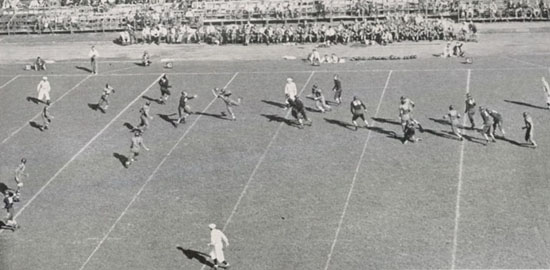
Missouri breaks up Ohio State pass. (University of Missouri Savitar Yearbook Class Of 1942)
On the fourth play of the fourth quarter, the Bucks started a possession on their 39 and shifted their attack into high gear. Charles Anderson took a pass behind the line of scrimmage and gained a first down on the Missouri 44. On third-and-four, a double reverse ended up with Anderson carrying on an end-around for 26y to the 12.
After a gain of 2y, Graf took a reverse and nearly scored but stumbled and fell on the one. He got the ball on the next play and finished the drive. Schoenbaum again missed the point. Ohio State 12 Missouri 0 .
Missouri finally struck like lightning with less than three minutes to play. Starting from the Ohio 37, sensational sophomore HB Maurice "Red" Wade went outside end for 8y. Then he bolted through tackle on a split-T dive play into the end zone. Suddenly Buckeye fans began to bite their fingernails. The extra point made it 12-7 Ohio State with two minutes left.
The Tigers tried an onside kick, but the kick did not cover the necessary 10y before being touched by the kicking team. When the next kickoff went out of bounds on the OSU 35, all the Buckeyes had to do was run out the clock. But on second down, Tom Kinkade fumbled, and G Ed Sweeney recovered for Missouri on the OSU 46.
To keep the ball from Missouri, Ohio State elected to run on a fourth-and-one situation near midfield and made the first down.
With time for only one more play, Steuber unleashed a long pass down the left sideline. Fisher leaped high and tipped it out of the eager fingers of Graf on the 10.
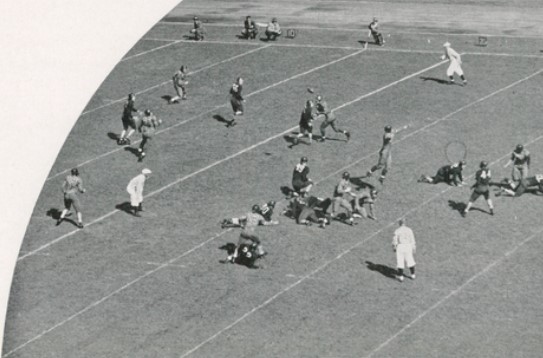
Ohio State throws a pass for a long gain. (University of Missouri Savitar Yearbook Class Of 1942
Postgame
The reason Ohio State didn't seem too surprised by Missouri's new offense came to light some time later. OSU Athletic Director St. John gave Faurot a copy of an expense account that had come across St. John's desk. One of Coach Brown's young assistants had spent time on the Missouri campus spying on the Tigers in their practice sessions, which were open to MU students and those who purported to be students. Brown did not mention that mission in his autobiography.
Brown recalled: "After the game Tink Ulrich (a friend from Massillon) said to me, "PB, if all you can do is 12 to 7 against this team, I'm afraid you're in for a long season.
"I think you're wrong about that," I told him. "Missouri is a fine football team, and they are go-ing to give people fits this year with that new offense."
Missouri didn't lose again until Fordham beat them 2-0 in the Sugar Bowl.
References
Ol' Mizzou: A Story of Missouri Football, Bob Broeg (1974)
PB: The Paul Brown Story, Paul Brown with Jack Clary (1979)
Paul Brown: The Rise and Fall and Rise Again of Football's Most Innovative Coach, Andrew O'Toole (2008)
Ol' Mizzou: A Story of Missouri Football, Bob Broeg (1974)
PB: The Paul Brown Story, Paul Brown with Jack Clary (1979)
Paul Brown: The Rise and Fall and Rise Again of Football's Most Innovative Coach, Andrew O'Toole (2008)